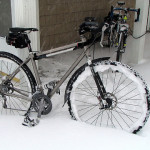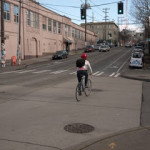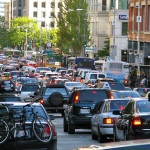Fresh from the holiday break, the State Legislature is slated on January 9 to head into its sprint of a 60-day legislative session. Washington Bikes will be lobbying on behalf of bicyclists statewide with its list of legislative priorities for 2012. At the top of that list includes continuing legislation from 2011 – substitute house bill (SHB) 1217: the Neighborhood Safe Streets Bill.
Sponsored by Representative Cindy Ryu (D-Shoreline), the legislation counts 17 co-sponsors and last year it passed 92-0 in the House of Representatives. The Neighborhood Safe Streets Bill’s supporters include a growing list of cities, organizations, and individuals from across the state.
This legislation paves the way for local governments – specifically cities and towns – to make safer streets and neighborhoods by allowing them the authority to set speed limits to 20 miles per hour on non-arterial streets. It does not mandate any change, it simply provides cities and towns the local control to do so.
Wait. Can’t cities and towns set speed limits below 25 miles per hour now?
In a word: no. Current Washington law prohibits municipalities from setting speed limits lower than 25 miles an hour except in very limited areas, such as school zones. If cities and towns do hope to go below this state-mandated minimum, they are required to conduct and administer an engineering and traffic study – a process requiring staff time and money.
Given the stresses of reduced budgets and staffing for transportation in cities and towns across Washington, the Neighborhood Safe Speeds Bill removes a hurdle in time and cost for local governments who want to create safer streets in our neighborhoods, residential business districts, parks, and to schools across the state.
The list is long for what the Neighborhood Safe Speeds Bill can do for cities and towns in Washington:
- Provides more local control. SHB 1217 is fundamentally a neighborhood speed safety bill that puts local governments in charge of non-arterial speed safety and takes the state out of the business of setting speed limits. Letting local governments decide safer maximum speeds is an approach that Idaho and British Columbia both take.
- Offers a safety tool in the local government toolbox. SHB 1217 offers an important tool for public and roadway safety. It can be accompanied with additional engineering and design to create safe neighborhood streets for all residents, particularly children and the elderly.
- Economic Development. Providing localities the authority to reduce speed limits in appropriate areas is an effective way to reduce speed limits near shopping districts, parks, and other areas their residents, elected officials, business leaders and other stakeholders deem important. Calmer streets provide more attractive places for business driven by foot traffic.
- Removes additional study costs and red tape currently required by the state. In a time of tight budgets, this bill removes a traffic and engineering hurdle that costs cities money and takes scarce staff time to administer.
- Promotes reduction of chronic disease and the growing obesity crisis. Public and private medical costs of obesity for our state are now estimated in excess of $3 billion. SHB 1217 can help ensure that neighborhoods provide spaces for safe physical activity and active transportation – both of which are on the decline compared to previous generations.
- Benefits Washington’s Safe Routes to School program. Safe neighborhood speeds help to promote walking and healthy activity in our communities. Lower speeds adjoining (but not formally linked) to existing school zones could help promote walking and biking to schools. This is likely to help reduce the epidemic of chronic disease related to obesity and lack of physical activity.
- Reduced speeds save lives. The chances of dying from a collision with a motor vehicle at 20 miles per hour is 5% compared to the 45% chance of death in a similar impact at 30 miles per hour. Slower speeds can be particularly important on non-arterial streets where we live and play.
This legislation provides cities and towns a template to create safer neighborhood streets, improve public health, reduce red tape, and save our cities and towns money. Most importantly, this legislation aligns with our values for making safe spaces to live, work, and play for our children, the elderly, and everyone who chooses to walk and bike around our neighborhoods, parks, residential business districts, and schools.
Get Involved!
Join us in urging the state legislature to take action on passing the Neighborhood Safe Speeds Bill during the 2012 session in the following ways:
Check back for Washington Bikes Action Alerts. During the 60-day legislative session (beginning on January 9) communicating your support of the Neighborhood Safe Speeds Bill will prove invaluable. We’ll be alerting our members, bill partners, and others when it’s necessary via email, blog, twitter and Facebook. Stay tuned!
Attend Transportation Advocacy Day on January 31! Join us for this all-day event on January 31 at United Churches in Olympia as we educate state policymakers on the issues and advocate for solutions. To RSVP, go directly to our partner, Transportation Choices Coalition, RSVP page: http://transportationchoices.org/action/transportation-advocacy-day-2012
Join our list of supporters! We’re looking to continue to expand support for this smart, cost-effective, and flexible legislation. Contact statewide policy director, Blake Trask, if you wish to add your city or organization to our list of Neighborhood Safe Speeds Bill supporters.



